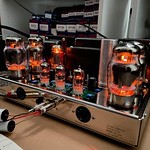+2
Bob Latino
knotscott
6 posters
Are Matched Output Tubes Necessary with VTA ST-70?

knotscott- Posts : 63
Join date : 2019-12-28
Location : Rochester, NY
With the independent bias adjustments of the VTA ST-70 PCB, how beneficial is it to match the output tubes?

Bob Latino- Admin
- Posts : 3277
Join date : 2008-11-26
Location : Massachusetts
knotscott wrote:With the independent bias adjustments of the VTA ST-70 PCB, how beneficial is it to match the output tubes?
It is always better to use a matched quad of output tubes BUT > A few times I have lost an output tube on my own VTA ST-120 and have replaced the bad tube with another NEW one of the same type > biased it up and listened to the music. I honestly could not tell any difference in the sound of the amp.
Bob
knotscott likes this post

nmchiefsfan- Posts : 78
Join date : 2012-03-21
I think it depends how hard you are driving them. At low volumes it should be fine but when you drive them harder you may start to notice when they switch to class AB

knotscott- Posts : 63
Join date : 2019-12-28
Location : Rochester, NY
Thanks guys. Sounds like it's a good idea, but not necessarily a must have. I don't push the volume much these days. My current EL34EH were matched, so I should be good to go for now.

KenGaler- Posts : 76
Join date : 2019-10-11
I wonder how they match them and what they mean when they say "matched". Color, smell, weight? I just bought two quad sets of matched KT120s from TAD, not cheap. I'm able to monitor each tubes bias current individually. Both sets have one tube that consistently is 5mA under the other three (in any position). In other words, if I set the left and right sides so that their hottest tube is 50mA, three are within 1mA at 50mA the the forth is closer to 45mA. And that's, of course, with the same bias as the other tube conducting 50mA. That's 10% low. Not what I would call matched.
I think that if the conditions where they select matching tubes is different than we're using them, we may see something less than a good match. Also, I wonder if the match drifts away as the tubes age.
I think when I buy replacements I'll not bother with paying for matched sets and see what happens.
Ken
I think that if the conditions where they select matching tubes is different than we're using them, we may see something less than a good match. Also, I wonder if the match drifts away as the tubes age.
I think when I buy replacements I'll not bother with paying for matched sets and see what happens.
Ken

peterh- Posts : 1869
Join date : 2012-12-25
Location : gothenburg, sweden
KenGaler wrote:I wonder how they match them and what they mean when they say "matched". Color, smell, weight? I just bought two quad sets of matched KT120s from TAD, not cheap. I'm able to monitor each tubes bias current individually. Both sets have one tube that consistently is 5mA under the other three (in any position). In other words, if I set the left and right sides so that their hottest tube is 50mA, three are within 1mA at 50mA the the forth is closer to 45mA. And that's, of course, with the same bias as the other tube conducting 50mA. That's 10% low. Not what I would call matched.
I think that if the conditions where they select matching tubes is different than we're using them, we may see something less than a good match. Also, I wonder if the match drifts away as the tubes age.
I think when I buy replacements I'll not bother with paying for matched sets and see what happens.
Ken
Matching has primarily 2 components :
- drawing same current in identical envorinment
This is essential to avoid DC in the output transformer. This req is possible to fulfill
at idle with individual adjustments, bet that won't help current balance at more power
- amplificates equally , Gm, any difference here will make one half of the signal smaller,
thus creating (primarily 2-tone) distortion. This is reduced by the use of NFB BUT NOT
TOTALLY

KenGaler- Posts : 76
Join date : 2019-10-11
peterh wrote:
Matching has primarily 2 components :
- drawing same current in identical envorinment
This is essential to avoid DC in the output transformer. This req is possible to fulfill
at idle with individual adjustments, bet that won't help current balance at more power
- amplificates equally , Gm, any difference here will make one half of the signal smaller,
thus creating (primarily 2-tone) distortion. This is reduced by the use of NFB BUT NOT
TOTALLY
Makes sense. I have no idea how far different non-matched tubes can be from each other. Maybe they can be 20-30mA off and 5mA is considered close.

corndog71- Posts : 840
Join date : 2013-03-19
Location : It can get windy here
Here’s an interesting take about power tube matching.
http://www.ramlabs-musicreference.com/virtues.html
http://www.ramlabs-musicreference.com/virtues.html

peterh- Posts : 1869
Join date : 2012-12-25
Location : gothenburg, sweden
KenGaler wrote:peterh wrote:
Matching has primarily 2 components :
- drawing same current in identical envorinment
This is essential to avoid DC in the output transformer. This req is possible to fulfill
at idle with individual adjustments, bet that won't help current balance at more power
- amplificates equally , Gm, any difference here will make one half of the signal smaller,
thus creating (primarily 2-tone) distortion. This is reduced by the use of NFB BUT NOT
TOTALLY
Makes sense. I have no idea how far different non-matched tubes can be from each other. Maybe they can be 20-30mA off and 5mA is considered close.
Tubes are in general +-25% and this is also how it was in "the good old days". It's small
mechanical builds assembled by hand at low cost. Engineers in the "good old days" knew
how to design and use tubes with spread parameters and still have the final product
to be well spec'ed and consistent. The need for matching anything but powertubes was
the exception. In addition many products needed trim-pots and coils at the final assembly.

KenGaler- Posts : 76
Join date : 2019-10-11
corndog71 wrote:Here’s an interesting take about power tube matching.
http://www.ramlabs-musicreference.com/virtues.html
Wow, that certainly talked me into buying matched sets. Thanks

KenGaler- Posts : 76
Join date : 2019-10-11
Moved to correct thread
Last edited by KenGaler on Sat Feb 15, 2020 12:08 pm; edited 1 time in total

KenGaler- Posts : 76
Join date : 2019-10-11
Moved to correct thread
Last edited by KenGaler on Sat Feb 15, 2020 12:09 pm; edited 1 time in total

KenGaler- Posts : 76
Join date : 2019-10-11
Moved to correct thread
Last edited by KenGaler on Sat Feb 15, 2020 12:10 pm; edited 1 time in total

knotscott- Posts : 63
Join date : 2019-12-28
Location : Rochester, NY
corndog71 wrote:Here’s an interesting take about power tube matching.
http://www.ramlabs-musicreference.com/virtues.html
That's an interesting read.....a little beyond my understanding, but still interesting!
I never really gave much thought about what tube matching meant. I just assumed it meant that they had similar measurements on a tube tester. I have no other way to check beyond the subjectivity of just listening to them.

peterh- Posts : 1869
Join date : 2012-12-25
Location : gothenburg, sweden
And the very important issue is that the readings are done at approximative same voltagesknotscott wrote:corndog71 wrote:Here’s an interesting take about power tube matching.
http://www.ramlabs-musicreference.com/virtues.html
That's an interesting read.....a little beyond my understanding, but still interesting!
I never really gave much thought about what tube matching meant. I just assumed it meant that they had similar measurements on a tube tester. I have no other way to check beyond the subjectivity of just listening to them.
and loads.

